2016 SUBARU BRZ oil temperature
[x] Cancel search: oil temperaturePage 178 of 490

177 2-1. Driving procedures
2
When driving
Manual mode driving
To enter manual mode, shift the select lever to the M position.
While the upshift/downshift indicator light is illuminated, gears can be
selected by operating the select lever or paddle shift levers, allowing
you to drive in the gear of your choosing.
Even if upshifting operations are performed, if vehicle speed is too low for
the requested gear, the gear will not change.
Upshift indicator
Downshift indicator
Upshifting (+)
Downshifting (-)
Each time the select lever or
paddle shift levers are operated,
the gear changes up or down
one gear and the selected gear,
“1” through “6”, will be set.
The selected gear, from “1” to “6”,
and “M” will be displayed on the
shift position and shift range indi-
cator.
When in manual mode, the gear will not change unless the select
lever or paddle shift levers are operated.
However, even when in manual mode, the gears will be automatically
changed in the following situations:
●When vehicle speed drops (downshift only).
●When engine oil temperature is high and engine speed rises close
to the red zone.
Page 296 of 490
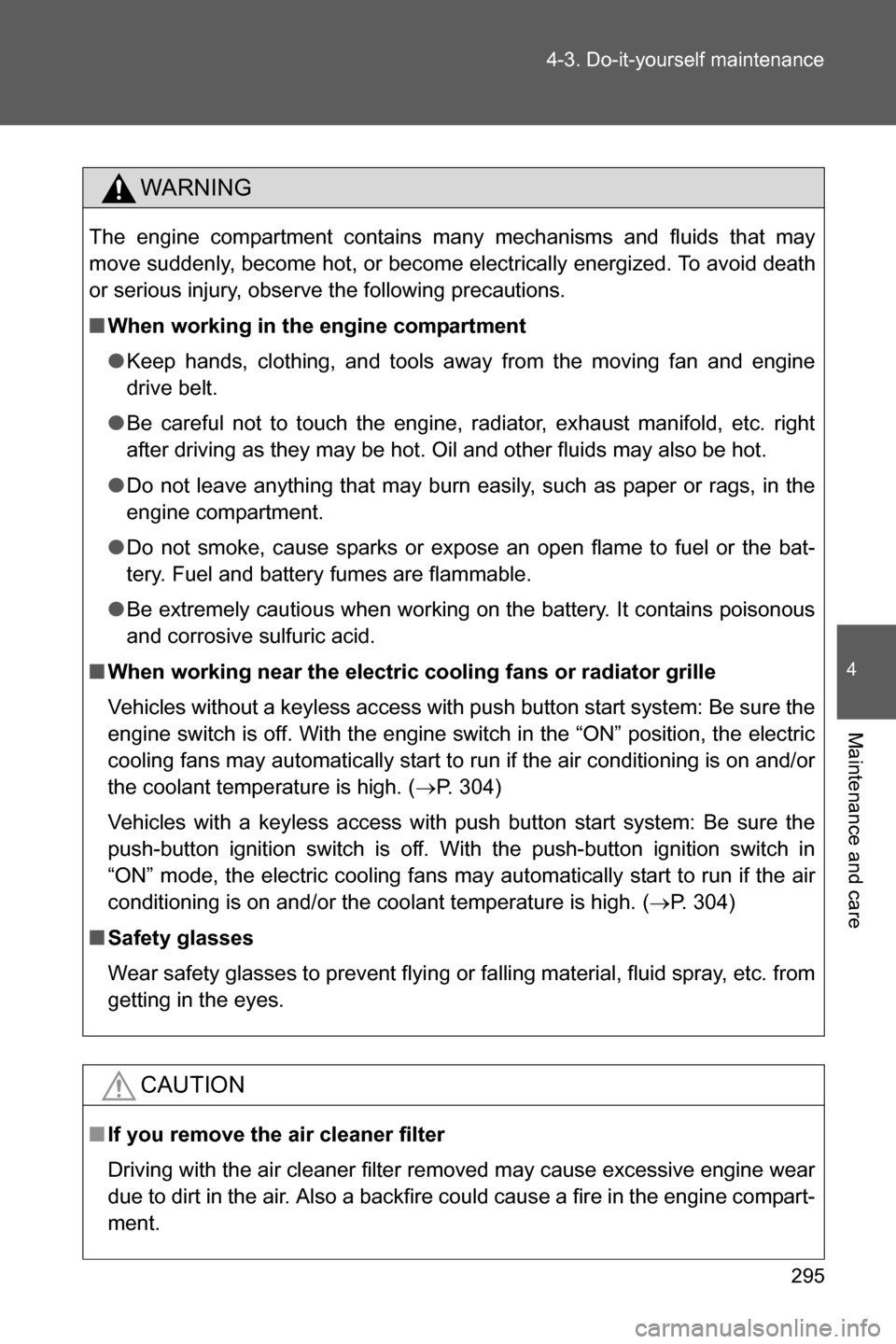
295 4-3. Do-it-yourself maintenance
4
Maintenance and care
WARNING
The engine compartment contains many mechanisms and fluids that may
move suddenly, become hot, or become electrically energized. To avoid death
or serious injury, observe the following precautions.
■When working in the engine compartment
●Keep hands, clothing, and tools away from the moving fan and engine
drive belt.
●Be careful not to touch the engine, radiator, exhaust manifold, etc. right
after driving as they may be hot. Oil and other fluids may also be hot.
●Do not leave anything that may burn easily, such as paper or rags, in the
engine compartment.
●Do not smoke, cause sparks or expose an open flame to fuel or the bat-
tery. Fuel and battery fumes are flammable.
●Be extremely cautious when working on the battery. It contains poisonous
and corrosive sulfuric acid.
■When working near the electric cooling fans or radiator grille
Vehicles without a keyless access with push button start system: Be sure the
engine switch is off. With the engine switch in the “ON” position, the electric
cooling fans may automatically start to run if the air conditioning is on and/or
the coolant temperature is high. (�oP. 304)
Vehicles with a keyless access with push button start system: Be sure the
push-button ignition switch is off. With the push-button ignition switch in
“ON” mode, the electric cooling fans may automatically start to run if the air
conditioning is on and/or the coolant temperature is high. (�oP. 304)
■Safety glasses
Wear safety glasses to prevent flying or falling material, fluid spray, etc. from
getting in the eyes.
CAUTION
■If you remove the air cleaner filter
Driving with the air cleaner filter removed may cause excessive engine wear
due to dirt in the air. Also a backfire could cause a fire in the engine compart-
ment.
Page 300 of 490
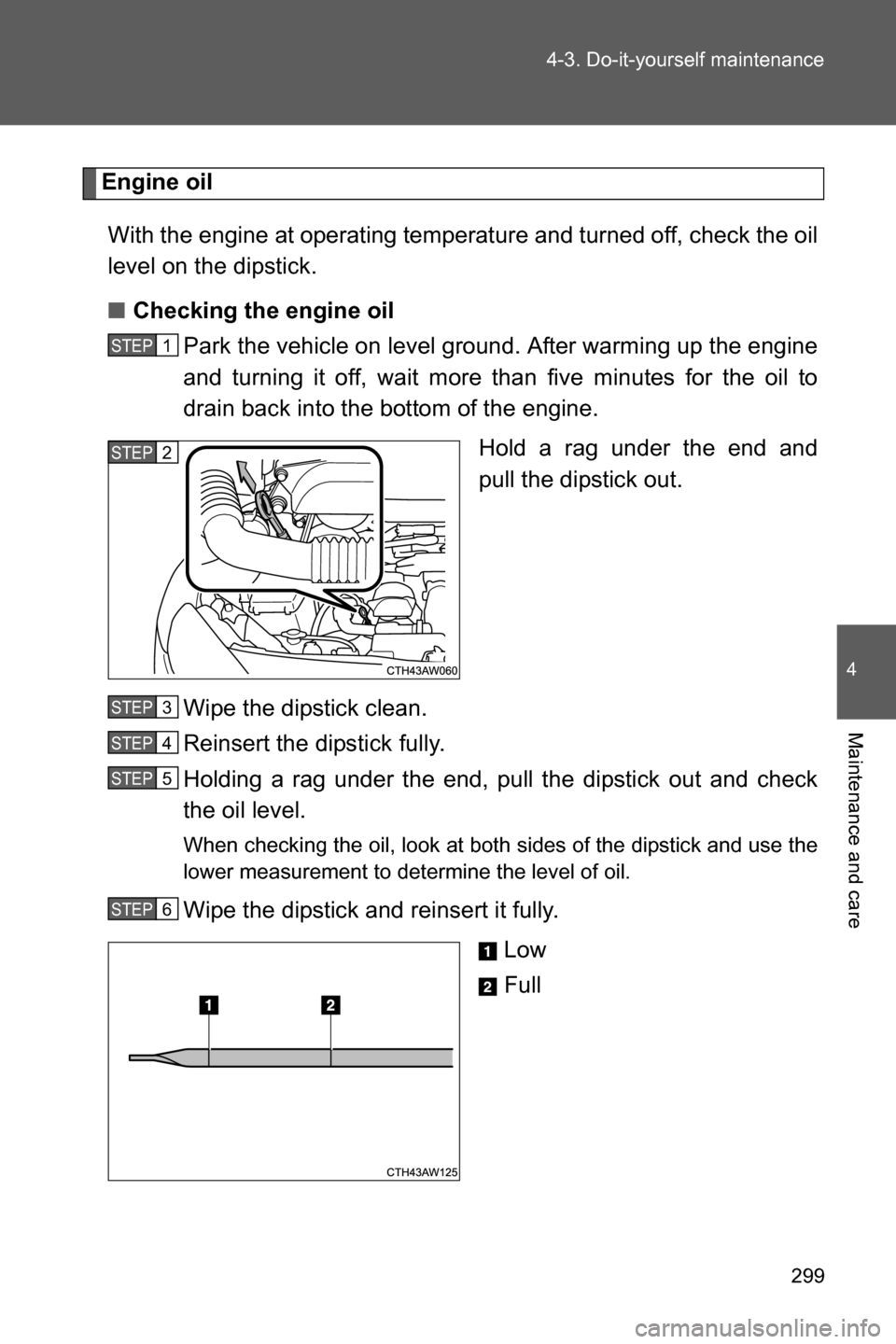
299 4-3. Do-it-yourself maintenance
4
Maintenance and care
Engine oil
With the engine at operating temperature and turned off, check the oil
level on the dipstick.
■Checking the engine oil
Park the vehicle on level ground. After warming up the engine
and turning it off, wait more than five minutes for the oil to
drain back into the bottom of the engine.
Hold a rag under the end and
pull the dipstick out.
Wipe the dipstick clean.
Reinsert the dipstick fully.
Holding a rag under the end, pull the dipstick out and check
the oil level.
When checking the oil, look at both sides of the dipstick and use the
lower measurement to determine the level of oil.
Wipe the dipstick and reinsert it fully.
Low
Full
STEP 1
STEP 2
STEP 3
STEP 4
STEP 5
STEP 6
Page 419 of 490
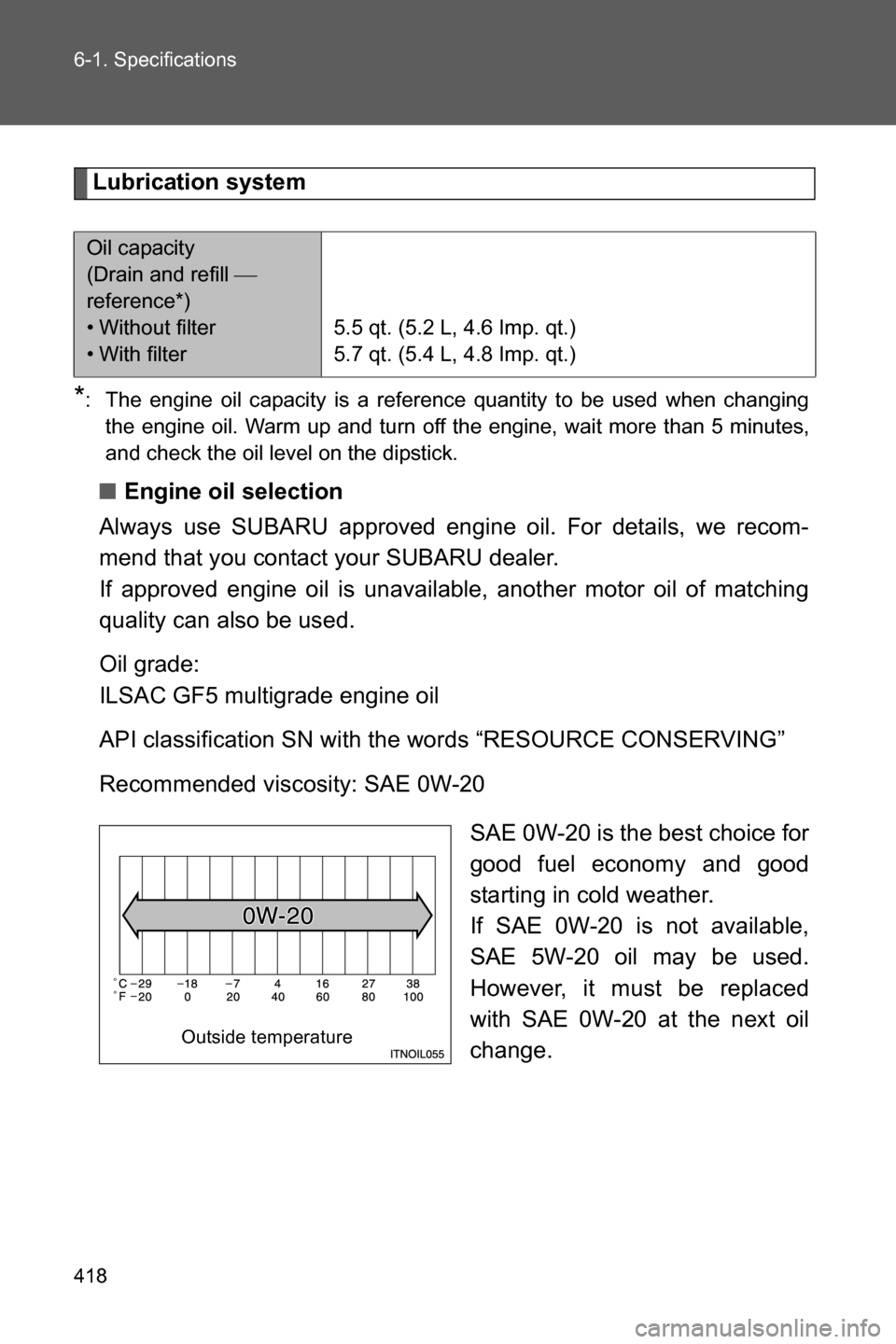
418 6-1. Specifications
Lubrication system
*: The engine oil capacity is a reference quantity to be used when changing
the engine oil. Warm up and turn off the engine, wait more than 5 minutes,
and check the oil level on the dipstick.
■Engine oil selection
Always use SUBARU approved engine oil. For details, we recom-
mend that you contact your SUBARU dealer.
If approved engine oil is unavailable, another motor oil of matching
quality can also be used.
Oil grade:
ILSAC GF5 multigrade engine oil
API classification SN with the words “RESOURCE CONSERVING”
Recommended viscosity: SAE 0W-20
SAE 0W-20 is the best choice for
good fuel economy and good
starting in cold weather.
If SAE 0W-20 is not available,
SAE 5W-20 oil may be used.
However, it must be replaced
with SAE 0W-20 at the next oil
change.
Oil capacity
(Drain and refill �
reference*)
• Without filter
• With filter5.5 qt. (5.2 L, 4.6 Imp. qt.)
5.7 qt. (5.4 L, 4.8 Imp. qt.)
Outside temperature
Page 420 of 490
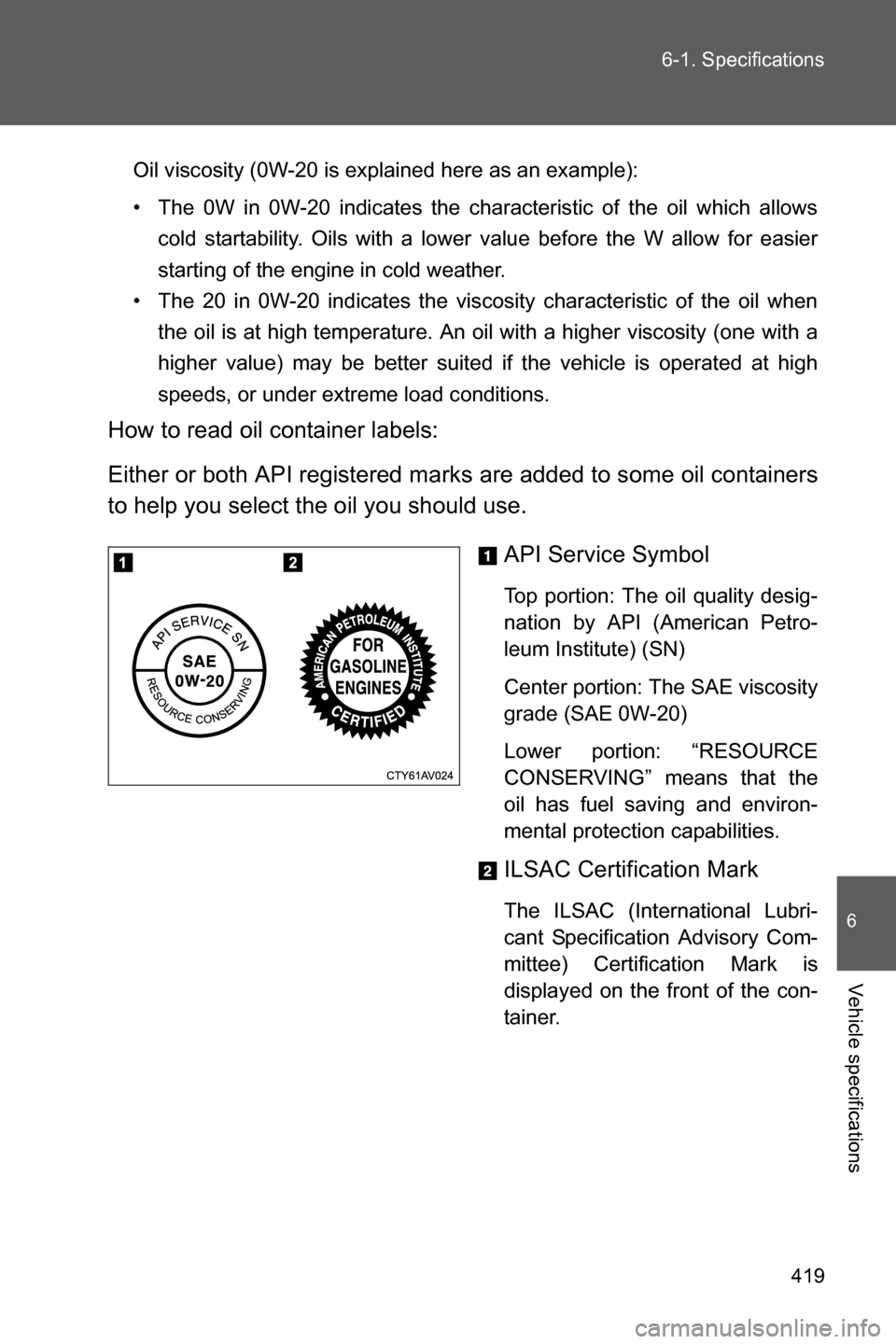
419 6-1. Specifications
6
Vehicle specifications
Oil viscosity (0W-20 is explained here as an example):
• The 0W in 0W-20 indicates the characteristic of the oil which allows
cold startability. Oils with a lower value before the W allow for easier
starting of the engine in cold weather.
• The 20 in 0W-20 indicates the viscosity characteristic of the oil when
the oil is at high temperature. An oil with a higher viscosity (one with a
higher value) may be better suited if the vehicle is operated at high
speeds, or under extreme load conditions.
How to read oil container labels:
Either or both API registered marks are added to some oil containers
to help you select the oil you should use.
API Service Symbol
Top portion: The oil quality desig-
nation by API (American Petro-
leum Institute) (SN)
Center portion: The SAE viscosity
grade (SAE 0W-20)
Lower portion: “RESOURCE
CONSERVING” means that the
oil has fuel saving and environ-
mental protection capabilities.
ILSAC Certification Mark
The ILSAC (International Lubri-
cant Specification Advisory Com-
mittee) Certification Mark is
displayed on the front of the con-
tainer.
Page 437 of 490
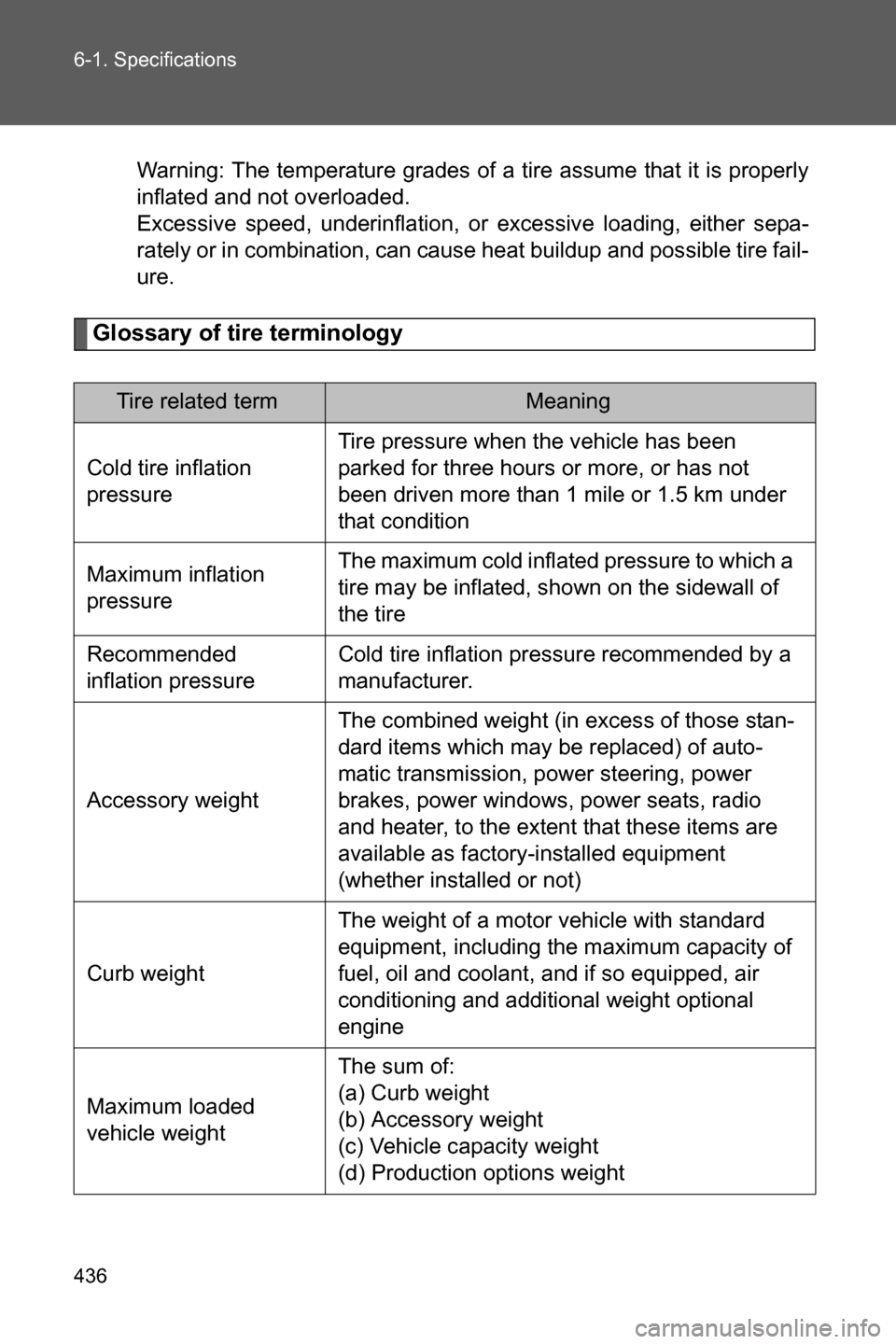
436 6-1. Specifications
Warning: The temperature grades of a tire assume that it is properly
inflated and not overloaded.
Excessive speed, underinflation, or excessive loading, either sepa-
rately or in combination, can cause heat buildup and possible tire fail-
ure.
Glossary of tire terminology
Tire related termMeaning
Cold tire inflation
pressureTire pressure when the vehicle has been
parked for three hours or more, or has not
been driven more than 1 mile or 1.5 km under
that condition
Maximum inflation
pressureThe maximum cold inflated pressure to which a
tire may be inflated, shown on the sidewall of
the tire
Recommended
inflation pressureCold tire inflation pressure recommended by a
manufacturer.
Accessory weightThe combined weight (in excess of those stan-
dard items which may be replaced) of auto-
matic transmission, power steering, power
brakes, power windows, power seats, radio
and heater, to the extent that these items are
available as factory-installed equipment
(whether installed or not)
Curb weightThe weight of a motor vehicle with standard
equipment, including the maximum capacity of
fuel, oil and coolant, and if so equipped, air
conditioning and additional weight optional
engine
Maximum loaded
vehicle weightThe sum of:
(a) Curb weight
(b) Accessory weight
(c) Vehicle capacity weight
(d) Production options weight
Page 479 of 490

478 Alphabetical index
Engine
Compartment ........................ 298
Engine hood .......................... 296
Engine switch ................162, 171
How to start the
engine .........................162, 171
Identification number............. 415
If the engine will not start ...... 393
Ignition switch................162, 171
Overheating........................... 407
Engine coolant
Capacity ................................ 420
Checking ............................... 302
Engine coolant temperature
gauge ...................................... 187
Engine hood ............................. 296
Engine immobilizer system....... 78
Engine oil
Capacity ................................ 418
Checking ............................... 299
Preparing and checking
before winter ....................... 229
Engine switch ...................162, 171
Engine switch light .................. 258
Event data recorder ...................16Floor mat .................................. 273
Fluid
Brake..................................... 304
Washer.................................. 310
Fog lights
Replacing light bulbs ............. 342
Switch ................................... 208
Wattage................................. 425
Front fog lights
Replacing light bulbs ............. 342
Switch ................................... 208
Wattage................................. 425
Front passenger occupant
detection system ................... 124
Front passenger's seatbelt
reminder light ........................ 371
Front seats
Adjustment .............................. 51
Front side marker light
Replacing light bulbs ............. 342
Wattage................................. 425
Front turn signal lights
Replacing light bulbs ............. 342
Switch ................................... 184
Wattage................................. 425
Fuel
Capacity ................................ 417
Fuel gauge ............................ 187
Fuel pump shut off system .... 367
Gas station information ......... 488
Information ............................ 426
Refueling................................. 74
Fuel door .................................... 74
Fuel filler lid................................ 74
Fuel pump shut off system ..... 367
Fuses ........................................ 334F
Page 482 of 490

481 Alphabetical index
Odometer ................................. 187
Oil
Engine oil.............................. 299
Opener
Engine hood ......................... 296
Fuel filler lid ............................ 74
Trunk lid.................................. 45
Outside rear view mirrors
Adjusting and folding .............. 67
Outside temperature
display ................................... 268
Overheating, Engine ............... 407
Parking brake .......................... 185
Parking lights
Switch ................................... 202
Power outlets........................... 269
Power windows ......................... 70
Radiator.................................... 304
Rear seats .................................. 54
Rear side marker lights
Replacing light bulbs ............ 342
Switch ................................... 202
Wattage ................................ 425
Rear turn signal lights
Replacing light bulbs ............ 342
Switch ................................... 184
Wattage ................................ 425
Rear window defogger............ 254
Replacing
Fuses.................................... 334
Key battery ........................... 329
Light bulbs ............................ 342
Tires ..................................... 382
Reporting safety defects
for U.S. owners ..................... 449
REV indicator........................... 152Seatbelts
Adjusting the seatbelt ..............58
Automatic Locking
Retractor (ALR).....................60
Child restraint system
installation ...........................138
Cleaning and maintaining
the seatbelts .......................281
Emergency Locking
Retractor (ELR).....................60
How to wear your seatbelt....... 58
How your child should
wear the seatbelt ..................60
Pregnant women,
proper seatbelt use ...............62
Reminder light .......................371
Seatbelt guide .........................59
Seatbelt pretensioners ............59
Seat heaters..............................271
Seating capacity.......................228
Seats
Adjustment ..............................51
Adjustment precautions...........52
Child seats/child restraint
system installation ..............138
Cleaning ................................280
Head restraint..........................56
Properly sitting in the seat .......87
Seat heaters ..........................271O
P
R
S